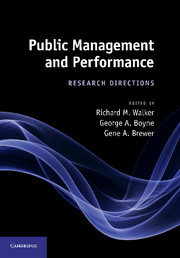Book contents
- Frontmatter
- Contents
- List of figures
- List of tables
- Notes on contributors
- 1 Introduction
- 2 Extending goal ambiguity research in government: from organizational goal ambiguity to programme goal ambiguity
- 3 Budgets and financial management
- 4 Organizational structure and public service performance
- 5 Red tape: the bane of public organizations?
- 6 Managerial networking, managing the environment, and programme performance: a summary of findings and an agenda
- 7 Public service motivation and performance
- 8 Organizational diversity and public service performance
- 9 Performance management: does it work?
- 10 Strategy: which strategic stances matter?
- 11 Methods
- 12 Conclusion: enriching the field
- Index
- References
2 - Extending goal ambiguity research in government: from organizational goal ambiguity to programme goal ambiguity
Published online by Cambridge University Press: 05 July 2014
- Frontmatter
- Contents
- List of figures
- List of tables
- Notes on contributors
- 1 Introduction
- 2 Extending goal ambiguity research in government: from organizational goal ambiguity to programme goal ambiguity
- 3 Budgets and financial management
- 4 Organizational structure and public service performance
- 5 Red tape: the bane of public organizations?
- 6 Managerial networking, managing the environment, and programme performance: a summary of findings and an agenda
- 7 Public service motivation and performance
- 8 Organizational diversity and public service performance
- 9 Performance management: does it work?
- 10 Strategy: which strategic stances matter?
- 11 Methods
- 12 Conclusion: enriching the field
- Index
- References
Summary
This chapter describes recent research on goal ambiguity (or goal clarity) in government organizations. Almost unanimously, scholars and experts say that public organizations have goals that are more multiple, conflicting and vague than the goals of business firms. (e.g. Allison 1983; Dahl and Lindblom 1953; Downs 1967; Drucker 1980; Frederickson and Frederickson 2006: 174; Heinrich 1999; Lowi 1979; Lynn 1981; Moynihan 2008: 142–5; Wildavsky 1979; Wilson 1989). These authors usually relate these characteristics of government organizations’ goals to other important organizational characteristics, such as greater difficulty in measuring performance and hence in achieving high performance; in maintaining organizational control; in avoiding ‘red tape’; and in motivating employees, as compared to business firms. To the extent that there are theories of government organizations, these observations play a central role in them. Many governmental reform initiatives include directives that government organizations state goals, clarify them and measure the extent to which they are achieved (Frederickson and Frederickson 2006; Gilmour 2006; Moynihan 2008: 28–31). In spite of the ubiquity of such observations about public organizations’ goals, researchers have reported few analyses of the goal characteristics of government organizations, or of organizations of any kind.
This chapter will review important examples of the assertions cited above about the goals of government organizations and the influences on the ambiguity of those goals. Then it will review recent research on the goals of public organizations. Next, the discussion will focus on recent studies that have analysed the level of goal ambiguity of large samples of government organizations and programmes (smaller organizational entities that are components of government agencies). These recent studies have developed measures of the level of goal ambiguity of such organizations and programmes, and have related those levels to other characteristics of the organizations and the programmes. The chapter then discusses the remaining challenges, and makes some propositions about the relations between goal ambiguity and clarity and the performance of public organizations.
- Type
- Chapter
- Information
- Public Management and PerformanceResearch Directions, pp. 34 - 59Publisher: Cambridge University PressPrint publication year: 2010
References
- 25
- Cited by



